 I play golf with Steve Brummer a few times per week, and I can safely say that the most consistent thing about his game is his inconsistency. Steve will play well for five holes, have a stretch where he doesn’t hit the ball well, and then finish out the round strong once again. While I joking refer to Steve as the “anti-Rotella” for his mental outlook (“even a blind squirrel finds a nut now and then” he’ll say after a good shot), his mental game is probably responsible for three to four dropped shots per round.
I play golf with Steve Brummer a few times per week, and I can safely say that the most consistent thing about his game is his inconsistency. Steve will play well for five holes, have a stretch where he doesn’t hit the ball well, and then finish out the round strong once again. While I joking refer to Steve as the “anti-Rotella” for his mental outlook (“even a blind squirrel finds a nut now and then” he’ll say after a good shot), his mental game is probably responsible for three to four dropped shots per round.
But here in Swing Check, we can’t analyze a person’s mental game, so we’ll fall back on Steve’s swing. It’s a swing which Steve has built over the 40+ years he’s been playing golf, and it’s a swing that, with a few tweaks with an eye on consistency, could generate a very repeatable golf swing.
Let’s have a look…
Address and Takeaway
According to Steve, his swing flaw used to be, like most golfers, a big slice. Today, Steve either snap hooks the ball or hits blocks out to the right with his driver. Almost once per round he’ll hit a towering popup.
To adjust for the slice he used to hit, Steve has developed a closed stance. Additionally, and compounding the problem, Steve takes the club back dramatically to the inside. You’ll hear a lot of pros say that they want to keep the clubhead “outside their hands” going back, and in the right side of the image, the clubhead should be to the right of the green vertical line at the hands, not behind Steve’s entire body.
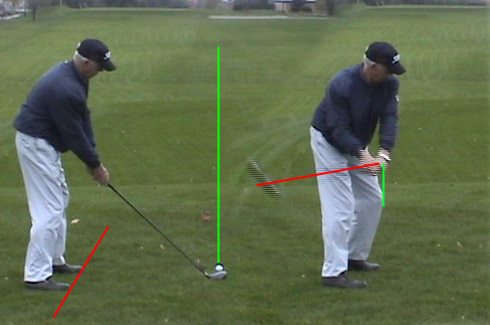
The closed stance and dramatically inside takeaway force a re-route on the way back down and get this swing off to a start from which it is nearly impossible to recover repeatably. We don’t need a comparison photo with a pro golfer to see that these positions could be improved.
This closed stance and inside takeaway is going to force a re-routing of the clubhead coming back down and is responsible for a significant portion of the swing problems from here on out.
Synchronized Hips and Shoulders
It’s been said that the downswing starts from the feet and travels through the knees, hips, torso, shoulders, arms, wrists, and ends at the clubhead, a virtual “unwinding” or “uncoiling” of the body led by the lower body. We hear about pros “clearing their hips” to allow room for their arms to swing down and through from the inside.
Having a downswing “in sync” is also a good thing, but not when you’re talking about your hips and shoulders. In comparing Steve’s downswing and particularly his impact position, note the fact that in each of the pro’s photos, you can see their left pocket. If you were to draw lines through their hips and shoulders at impact, you’d see quite an angle as you see in Chris DiMarco’s photo (far right in pro swings).
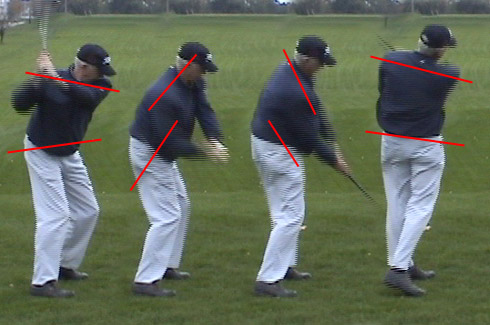
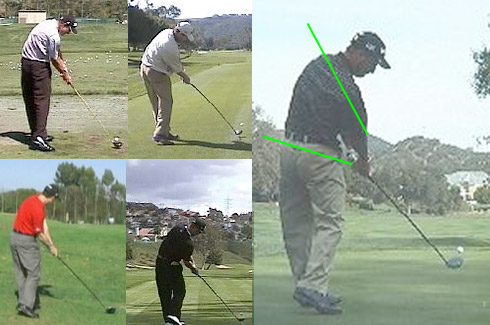
Chris DiMarco (and others) successfully clear their hips (you can see their left back pocket in each photo) at impact, while Steve (top) remains too closed relative to his shoulders.
I have a hunch that a large portion of this problem stems from the problem we first mentioned – the closed stance. Closing your stance inhibits the ability of the hips to clear. This creates crowding and cramping in the downswing, as the right hip – not rotating through quickly enough – gets in the way of the right elbow, which is then trying to drop into a slot that’s not yet available.
Over the Top
With the closed stance and the synchronized hips, it’s then nearly impossible to drop the club to the inside. Though it sounds odd with such a closed stance, Steve comes over the top simply because he doesn’t have the room to come down the target line. You can see in the images below that he’s “standing up” a bit out of the shot in an attempt to create more room. Unfortunately, all that will manage to do is create the exact opposite situation: standing up pushes the right hip further into area which the hands want to occupy, further crowding the downswing.
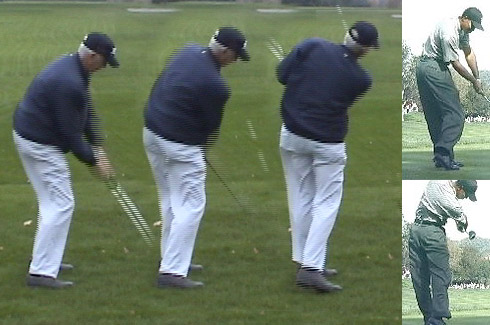
The “outside in” swing produces either weak soft cuts or deadly pulls and pull-hooks.
As you can see above, Tiger Woods comes down the line and finishes through the line. You can see his arms in front of his body when his club reaches parallel, while Steve’s hands disappear behind his body before the ball has managed to get more than five yards off the clubface.
This isn’t a flaw I’d specifically work on, because I believe that if the first two things are fixed, a more natural “down the line” swing will follow.
Casting with Short Arms
While casting may be great for fishing, it’s not great in golf. Casting got its name because it involves throwing the arms and snapping the wrist at nearly the same moment. People who “cast” at the top of the backswing lose the angle between their forearms and their club’s shaft and appear to be casting a fishing rod as they begin their downswing.
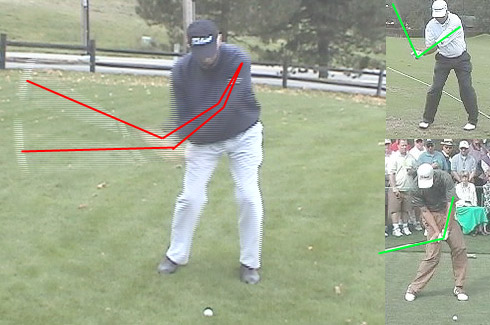
Steve, seen here, is casting relatively late in his swing but still early enough to lose a tremendous amount of power.
Steve doesn’t cast at the top of the backswing, but he does lose the angle between his forearms and his club shaft earlier than most better golfers. In doing so, he gives up a lot of power that “cracking the whip” at the last possible instant provides. Kenny Perry and Sergio Garcia, both regarded as great drivers of the golf ball, both maintain their wrist cock or “lag” very late into the downswing. Kenny Perry, seen above, has greater than 90° almost halfway down while Sergio is still at about 70° even as his left arm approaches the golf ball.
A lot of people who cast early are afraid of getting too far ahead of the ball or of hitting the ball with such a descending blow that they might stick the clubhead in the ground and leave it there. Increasing lag (delaying the uncocking of the wrists on the downswing) is one of the easiest ways to increase distance.
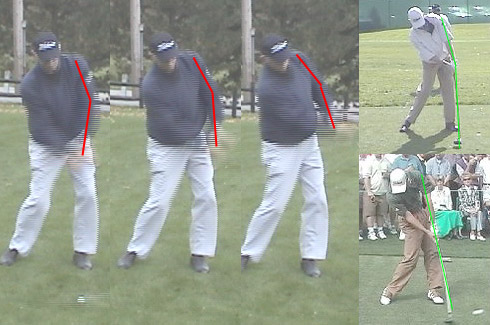
The left arm should remain fairly straight just before, during, and just after impact.
Though it’s evident in the casting photo above, another flaw becomes evident at and beyond impact: a collapsing left arm. Sergio Garcia, seen in the bottom right photo above, maintains a straight left arm, the line of which extends down his driver shaft. Steve’s left arm bends before and after impact, resulting in a narrower swing arc and diminished power and accuracy. While a lot of this stems to the setup and takeaway, which have caused a chain reaction of problems, this is also a flaw which can be fixed and worked on independently of setup.
Head Movement
“Keep your head down” is one of the worst pieces of golf advice ever given, but “keep your head still” may be one of the best. A still head provides a still neck and a still spine about which your body can rotate. A still head provides a consistent “bottom” to your swing.
A moving head moves all those things, and if you’re rotating about a moving axis and the bottom of your swing is sliding left and right, consistent contact will be difficult at best.
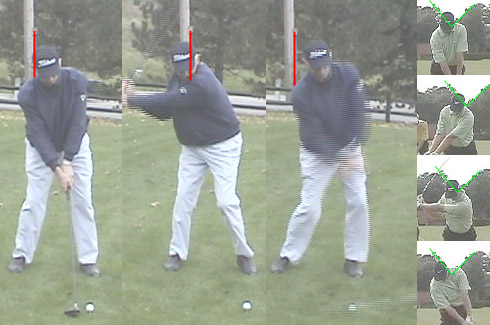
Ernie Els’ head moves back slightly from setup to impact, but it stays within a very small range. Steve’s head, as judged the by the box on the telephone pole, moves dramatically back and forward.
Steve’s head, largely due to an effort to maintain a good weight shift in the absence of incredible flexibility, moves to his right during his backswing and then forward through impact as much as eight inches. With a driver in particular, your head should be behind the golf ball at impact, so I’m a big fan of setting it behind the ball at setup and then leaving it there.
It may behoove Steve to imagine a spike going through his spine and into the ground. He can’t move his head with a spike through his spine, and it provides a great image of rotating around the spine (and thus the head). With a more consistent head position, the bottom of his swing will in turn be more consistent, and ball striking will improve.
In Conclusion
Aside from the head movement, Steve’s swing is largely a matter of setup and takeaway. The over-the-top move, the hips failing to clear, and even the casting and the lack of lag or straight arms at impact all follow. With a square to slightly open setup, Steve’s takeaway will be longer and more on plane. He won’t re-route the club to the outside, and it’ll drop into a slot. Coming from the inside, lag will increase and the right hip will be forced to clear to give room.
Flaws at setup can happen quite frequently, and the pros realize this. They practice their setup position far more than the average amateur can imagine, and for good reason: a proper setup puts you in position to make a good swing, while improper setup sets in motion a cascade of compensation.
Lastly, let me point out that Steve’s swing is far from atypical. In fact, the casting, the crooked left arm, the head movement… they’re all very common flaws. You – or the other three members of your foursome – probably exhibit several of these flaws, and you’d do well to think about how you could improve your swing. You probably look a bit more like Steve than you’d like to believe.
this could be video with my swing on it (just add about 30lbs around the belly). Great review, makes me want to run to the driving range right now !
My club pro has told me I cast from the top too and has given me a couple drills to work on to reduce it. But, it’s been over a year and I still can’t seem to quit doing it. Any advice?
Brad,
I have a little tip for you here.
It’s the first post at the top of the page. Try this drill a few times and see if it helps keep you from casting. I can’t guarantee anything, but it helped me understand how to keep the angle between my arms and shaft as long as I could before impact.
Excellent! You guys will get me scoring in the 80s yet (for 18)–yeah, I’m that bad.
I think I have trouble casting. I try to swing rotating the hands and clubs around my neck, and on plane, but somehow I get a pull, a slice, a push-slice, and sometimes just a push. I don’t really get duck hooks. I’ve REALLY been struggling lately. Thus, I’m squeamish about a super delayed release. But I have found that getting that right elbow in to the right hip pocket really slings that clubhead forward. Often now I really feel a “snap” of the clubhead forward, and it seems to be coming not so “delayed”, yet I hit the ball a LONG way when I feel this (e.g. 6 iron goes 190), and the flight is very high. And it seems I do all the powering in the stroke well before contact, that the “snap” comes when the right elbow comes fully “in” (to the right side). But quite often I get that right elbow sliding, like as if I’m pulling down too long and hard, that I can’t get the right elbow “in” and “snap the clubhead forward. I feel a tremendous need to do “fancy” things with the hands and arms to salvage shots. Can you help me here?
Great article. I’m a 4th year player and I made self-corrections to go from being a fader/slicer to a drawer/hooker. Ball flight is straight or slight pull.
Obviously I had overdone something or gotten on the wrong track.
Just had a lesson with a fantastic pro up in NH who immediately saw that I was taking the club back too far inside and that my position at the top was too deep (right elbow practically behind me). So – as you’ve articulated above – I had no chance of dropping into a good slot without a little over the top move -bad news!
The #1 correction was to keep the clubhead outside of my hands on takeaway, and to not allow my right elbow to migrate behind me. A great sensation to help this happen is the old Hogan thought of keeping your elbows and arms close together. Finally, he had me go to a slightly open stance (not necessarily permanently, but to get me “unstuck”). All I can say is that while I have a lot of work to do, this was a huge eye opener. If your swing looks like Steve’s above (keep at it Steve!), you will benefit IMMEDIATELY from keeping the clubhead outside of your hands on the way up to the top. It will feel a little funny at first – but give it a shot.